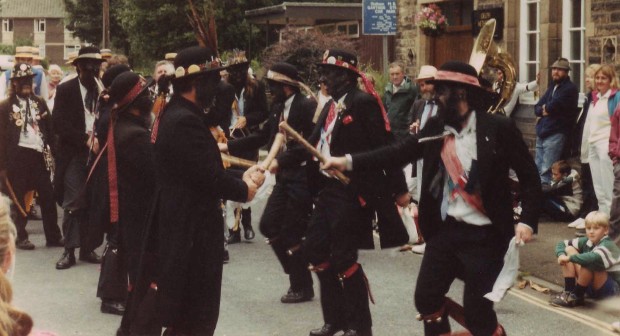Border Morris: Difference between revisions
(New page: === Border Morris === The border in question is the English-Welsh border. The style of dancing from this area is characterised by men who blacken their faces as a disguise, and often wear ...) |
mNo edit summary |
||
| (3 intermediate revisions by 2 users not shown) | |||
| Line 1: | Line 1: | ||
=== Border Morris === | === Border Morris === | ||
The border in question is the English-Welsh border. The style of dancing from this area is characterised by men who blacken their faces as a disguise, and often wear rag jackets. The dances are generally stick dances, and the emphasis tends to be on enthusiasm and spectacle rather than the grace and precision of [[ | The border in question is the English-Welsh border. The style of dancing from this area is characterised by men who blacken their faces as a disguise, and often wear rag jackets. The dances are generally stick dances, and the emphasis tends to be on enthusiasm and spectacle rather than the grace and precision of [[Cotswold Morris]]. | ||
[[Image:Silurian1.JPG]] | |||
Silurian Border Morris at [[Saddleworth Rushcart]] c.1993 Photo ©John Adams | |||
Here are two academic items about the history of the practice of Blacking Up, which some Border sides use, and which has been recently controversial:- | |||
'''‘Blacking Up’: English Folk Traditions and Changing Perceptions about Black People in England''' [http://etheses.whiterose.ac.uk/4181/1/MPhil_upload.pdf]; Patricia Bater; National Centre for English Cultural Tradition, Sheffield University | |||
Submitted for the degree of Master of Philosophy, March 2013 | |||
'''To Black up or Not to Black Up : A Personal Journey''' [https://www.academia.edu/5468139/To_Black_up_Or_Not_to_Black_Up_A_Personal_Journey]; Chloe Elizabeth Middleton-Metcalf | |||
A summary from undergraduate research which sums up academic opinion regarding border morris (as per 2014) (Morris Federation website) | |||
Latest revision as of 08:41, 6 September 2016
Border Morris
The border in question is the English-Welsh border. The style of dancing from this area is characterised by men who blacken their faces as a disguise, and often wear rag jackets. The dances are generally stick dances, and the emphasis tends to be on enthusiasm and spectacle rather than the grace and precision of Cotswold Morris.
Silurian Border Morris at Saddleworth Rushcart c.1993 Photo ©John Adams
Here are two academic items about the history of the practice of Blacking Up, which some Border sides use, and which has been recently controversial:-
‘Blacking Up’: English Folk Traditions and Changing Perceptions about Black People in England [1]; Patricia Bater; National Centre for English Cultural Tradition, Sheffield University
Submitted for the degree of Master of Philosophy, March 2013
To Black up or Not to Black Up : A Personal Journey [2]; Chloe Elizabeth Middleton-Metcalf A summary from undergraduate research which sums up academic opinion regarding border morris (as per 2014) (Morris Federation website)
